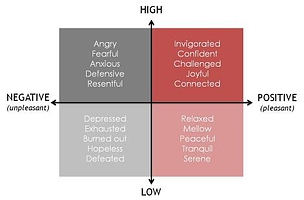Overuse. In the Power of Full Engagement the authors use an example of a sprinter versus a long distance runner. The picture here suggests the contrast of someone who is constantly overusing their energy resources versus the person who recovers after short sprints. Underuse could dramatically show someone who is obese, fails to exercise at all. Yet the important thing to recognize is the critical balance we must make in using our energy and not using it.
Think for a moment about the look of many long-distance runners: gaunt, sallow, slightly sunken and emotionally flat. Now visualize a sprinter such as Usain Bolt. 
 Sprinters typically look powerful, bursting with energy and eager to push themselves to their limits. The explanation is simple. No matter how intense the demand they face, the finish line is clearly visible 100 or 200 meters down the track. We, too, must learn to live our own lives as a series of sprints—fully engaging for periods of time, and then fully disengaging and seeking renewal before jumping back into the fray to face whatever challenges confront us.
Sprinters typically look powerful, bursting with energy and eager to push themselves to their limits. The explanation is simple. No matter how intense the demand they face, the finish line is clearly visible 100 or 200 meters down the track. We, too, must learn to live our own lives as a series of sprints—fully engaging for periods of time, and then fully disengaging and seeking renewal before jumping back into the fray to face whatever challenges confront us.
Here’s what Tony Schwartz and Jim Loehr discovered, “Because energy capacity diminishes both with overuse and with underuse, we must balance energy expenditure with intermittent energy renewal. In fact, increased demand progressively depletes our energy reserves—especially in the absence of any effort to reverse the progressive loss of capacity that occurs with age. By training in all dimensions we can dramatically slow our decline physically and mentally, and we can actually deepen our emotional and spiritual capacity until the very end of our lives.
Sadly, the need for recovery is often viewed as evidence of weakness rather than as an integral aspect of sustained performance. The result is that we give almost no attention to renewing and expanding our energy reserves, individually or organizationally.
To maintain a powerful pulse in our lives, we must learn how to rhythmically spend and renew energy.”
As noted in Time Management - Managing Energy Versus Managing Time our lives, engaged in a typical work environment, demands much more energy and thus a higher demand for renewal and recovery than any athlete.
PRINCIPLE 2: Energy Capacity Diminishes Both With Overuse And Underuse. We Must Balance Energy Expenditure With Intermittent Energy Renewal.
How often do you take time to rest and recover during the day? You may even be afraid to do so because of the consequences you might get from merciless boss who insists you work long hours.
Balancing stress and recovery is critical in managing energy in all facets of our lives.  As we expend energy we draw down our reservoir. Recovery brings it back. Too much energy expended without sufficient recovery eventually leads to burnout and breakdown. Simply stated it’s overuse it and lose it. The opposite side of this is too much recovery without sufficient stress leads to atrophy and weakness. Use it or lose it. Did you realize that the benefits of a sustained fitness program decrease significantly after just one week of activity and disappear altogether in as few as four weeks?
As we expend energy we draw down our reservoir. Recovery brings it back. Too much energy expended without sufficient recovery eventually leads to burnout and breakdown. Simply stated it’s overuse it and lose it. The opposite side of this is too much recovery without sufficient stress leads to atrophy and weakness. Use it or lose it. Did you realize that the benefits of a sustained fitness program decrease significantly after just one week of activity and disappear altogether in as few as four weeks?
Emotionally, physically, mentally and spiritually we need to expand our capacity and recover. This principle is called Oscillation. Energy is the capacity to do work. Oscillation is the fundamental pulse of life.
Unfortunately working at a feverish pace without breaks can be an addiction.
The Power of Full Engagement suggests, learning to establish stopping points in our days inviolable times when we step off the track, ease processing information and shift our attention from achievement to restoration. In Japan they have a term for death by overwork: karoshi. In fact the Japanese government’s Ministry of Labor began to publish statistics on karoshi in 1987. Here’s some frightening statistics. The number of Japanese workers who put in more than 3120 hours a year (an average of over 60 hours a week) increased from three million (15% of workforce) to seven million (24%) from 1975 to 1988. No comparable research exists in the United States, yet America is the only country in the world in which employees work more hours per week than the Japanese.
Can taking breaks to recover help you perform better? One example in the book (William D.) began taking a break every 90 to 120 minutes. He would eat something drink some water and take a brief walk. On this change alone within two weeks he estimated a 30% increase in his energy each afternoon.
Use it or lose it. Simple recommendation here is find a way to take a break every 90 minutes in your day. Get up, stretch, take a short work, go to your break room whatever to get away from your work for 5-15 minutes. You’ll quickly discover you have more energy and be more productive!
Principle #3 is about when stress is good. When do we need to push ourselves beyond our normal limits and what can we learn from athletic training to help us increase our capacity to work? That’s next blog.






.jpeg?width=150&height=135&name=Hand%20with%20marker%20writing%20the%20question%20Whats%20Next_%20(1).jpeg)

